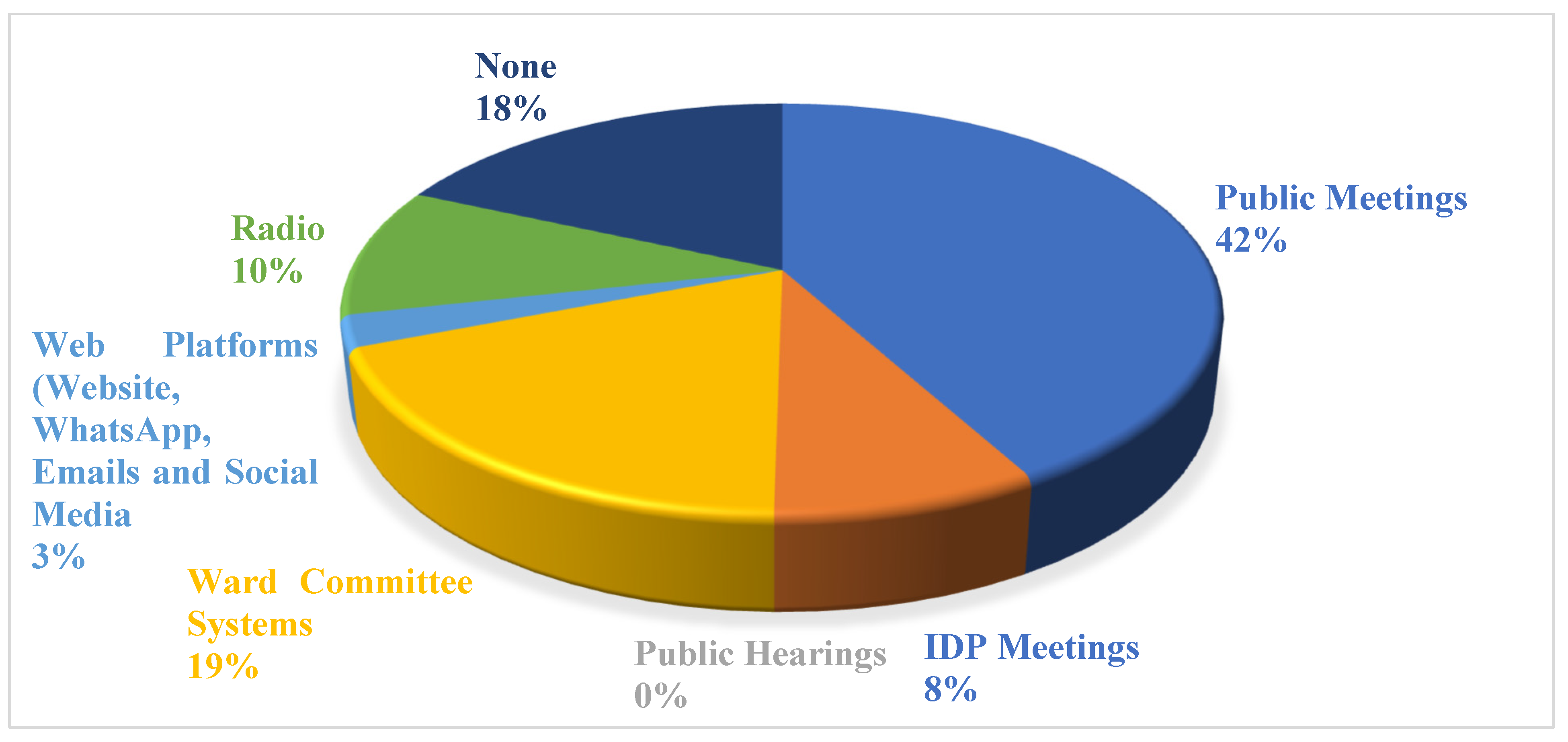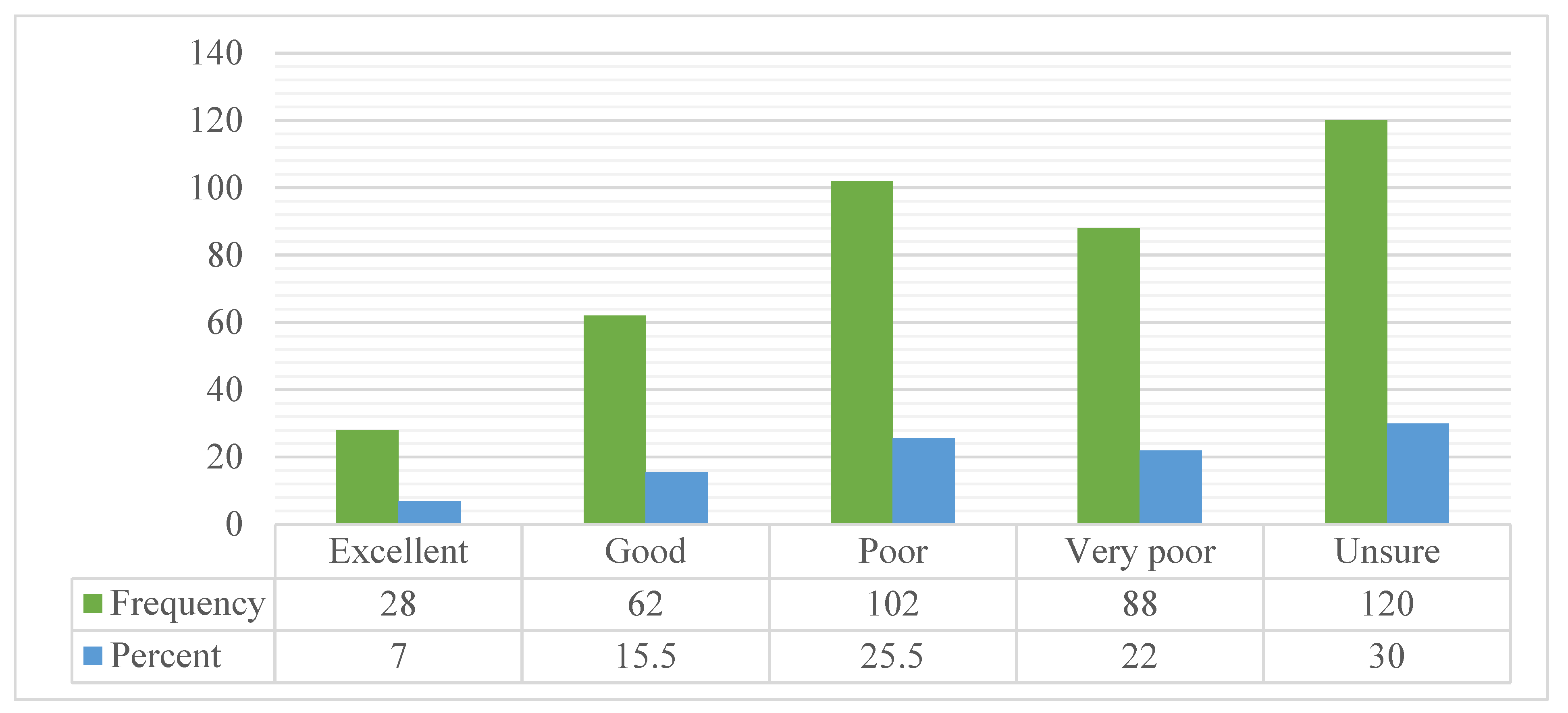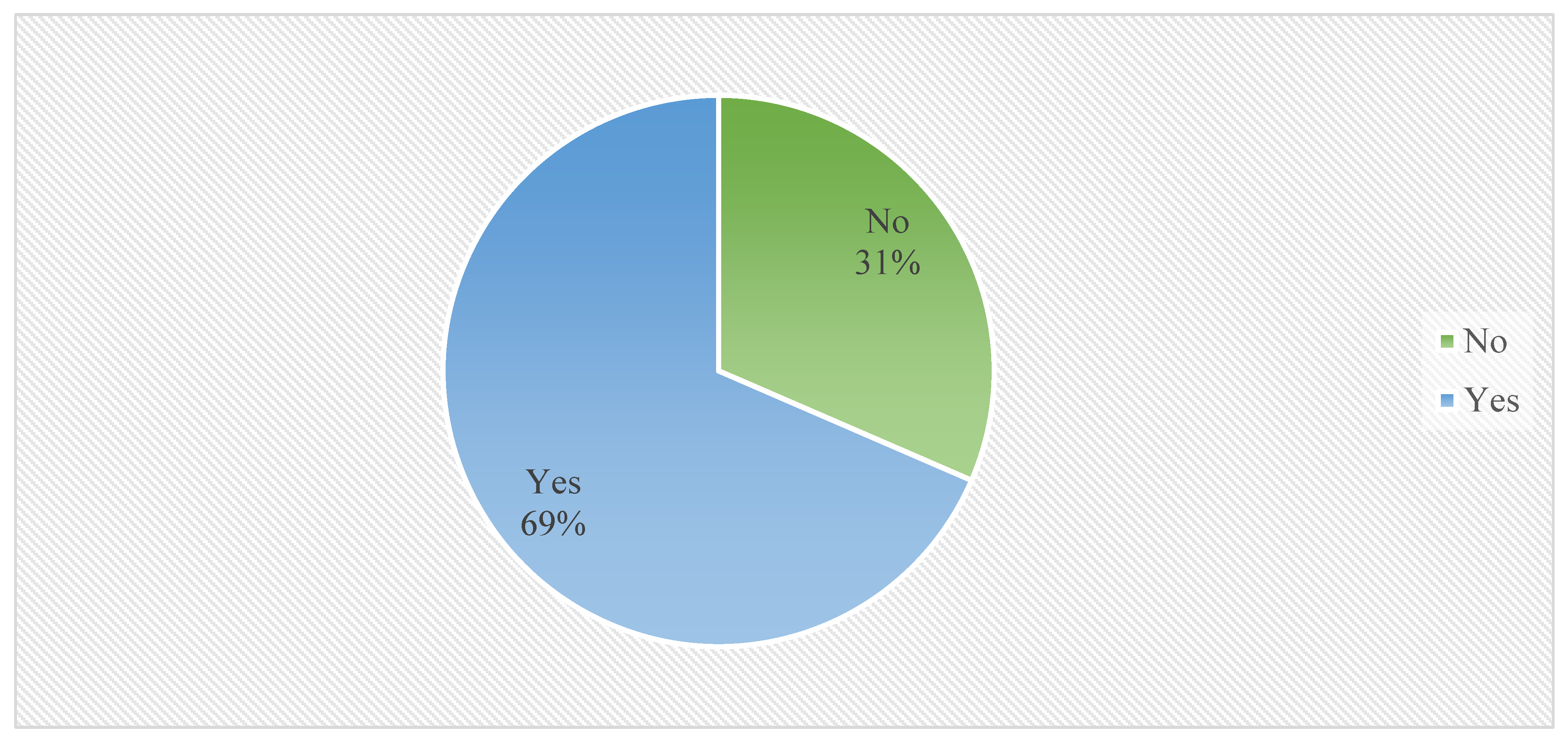A Review of Mechanisms Used to Improve Community Participation in the Integrated Development Planning Process in South Africa: An Empirical Review
Abstract
1. Introduction
2. Problem Statement
3. Theoretical Framework
4. Research Methods and Design
5. Findings and Discussion
5.1. Presentation of Quantitative Findings
5.1.1. Forums, Structures and Mechanisms
5.1.2. Most Used and Applied Mechanisms by the Municipality
5.1.3. Level of Community Participation Based on the Mechanisms
5.1.4. Delivered Projects and Services as Stipulated in the IDP Document
5.1.5. Implementation and Completion of Projects
5.2. Presentation of Qualitative Findings
5.2.1. Understanding Community Participation
“Community participation is an important aspect of the IDP because it allows the stakeholders to propose, negotiate and monitor their projects”. While the other key informants indicated that; “It is a method of incorporating the community in decision-making about developmental projects or programmes in their area”.
5.2.2. Communities Involvement in the IDP Process and Decision-Making
“Yes, during the IDP Representative Forum, the Mayor presents the plans, and the stakeholders, including the communities, are given a chance to comment and give input. The following inputs and comments were received from stakeholders in the compilation of the 2021–2022 IDP; Senakwe, Matipane to Morapalala road upgrading to tar or paving, Street maintenance in Tzaneen town, Street lights at Letaba River Estate, Constant power outage at Flora Park, Abandoned borehole project at Mohlaba Cross, water, boreholes, paving of internal streets, new primary school, electricity in extensions, maintenance of tar road, sanitation, RDP houses, jobs, community hall, Apollo lights at bus stops, and Water shortage at Banana among others.”.
5.2.3. Mechanisms to Facilitate Community Participation
“We used various means to reach out to community members, including through SMS, social media, word of mouth and loud hailing. We also used community development facilitators, community development workers, Ward Committees, traditional leaders, and other groups to help facilitate community participation”.
“Yes, the community participation for 2020/2021 IDP/Budget was done through the media, social media, internet, radio, e-mails, website, WhatsApp groups, pamphlets, etc., due to the National Disaster Management Act and COVID-19 regulations. We also provided the transport and catering during the consultation process”.
5.2.4. Effectiveness of the Mechanisms
“Yes, since the communities’ and other stakeholders’ levels of participation have improved over time. The municipality has successfully and fruitfully involved communities and other stakeholders. Despite our efforts to ensure that communities are informed prior to the public meetings, community turnout is minimal”.
6. Discussion
7. Conclusions and Recommendations
Author Contributions
Funding
Institutional Review Board Statement
Informed Consent Statement
Data Availability Statement
Conflicts of Interest
References
- Asha, Aklilu, and Kagiso Makalela. 2020. Challenges in the implementation of integrated development plan and service delivery in Lepelle-Nkumphi Municipality, Limpopo Province. International Journal of Economics and Finance Studies 12: 1–14. [Google Scholar] [CrossRef]
- Bamberger, Michael. 1988. The Role of Community Participation in Development Planning and Project Management. Washington, DC: The World Bank. [Google Scholar]
- Bardill, John. 2000. Towards a culture of good governance: The Presidential Review Commission and public service reform in South Africa. Public Administration and Development 20: 103–17. [Google Scholar] [CrossRef]
- Bourgon, Jocelyne. 2007. Responsive, responsible and respected government: Towards a New Public Administration theory. International Review of Administrative Sciences 73: 7–26. [Google Scholar] [CrossRef]
- Burns, Nancy, and Susan Grove. 2005. The Practise of Nursing Research: Conduct, Critique, and Utilization, 5th ed. St. Louis: Elsevier, p. 52. [Google Scholar]
- Diefenbach, Thomas. 2009. New public management in public sector organisations: The dark sides of managerialistic ‘enlightenment’. Public Administration 87: 892–909. [Google Scholar] [CrossRef]
- Dyum, Thami. 2020. The Extent of Public Participation in the Formulation of the IDP: The Case of Beaufort West. Master’s dissertation, University of the Western Cape, Cape Town, South Africa. [Google Scholar]
- Enwereji, Prince Chukwuneme, and Dominique Emmanuel Uwizeyimana. 2020. Enhancing democracy through public participation process during covid-19 pandemic: A review. Gender and Behaviour 18: 16873–88. [Google Scholar]
- Gruening, Gernod. 2001. Origin and theoretical basis of New Public Management. International Public Management Journal 4: 1–25. [Google Scholar] [CrossRef]
- Islam, Fakhrul. 2015. New Public Management (NPM): A dominating paradigm in public sectors. African Journal of Political Science and International Relations 9: 141–52. [Google Scholar]
- Kalimullah, Nazmul Ahsan, Kabir Ashraf Alam, and Ashaduzzaman Nour. 2012. New public management: Emergence and principles. But Journal 1: 1–22. [Google Scholar]
- Malatji, Khutso Peace. 2019. Community Participation in Development Projects as Tickyline Village in Tzaneen. Master’s dissertation, University of Venda, Thohoyandou, South Africa. [Google Scholar]
- Mamokhere, John, Mavhungu Elias Musitha, and Victor Mmbengeni Netshidzivhani. 2021. The implementation of the basic values and principles governing public administration and service delivery in South Africa. Journal of Public Affairs 22: e2627. [Google Scholar] [CrossRef]
- Mamokhere, John, and Daniel Francois Meyer. 2022. Including the excluded in the integrated development planning process for improved community participation. International Journal of Research in Business and Social Science (2147–4478) 11: 286–99. [Google Scholar] [CrossRef]
- Marston, Cicely, Alicia Renedo, and Sam Miles. 2020. Community participation is crucial in a pandemic. The Lancet 395: 1676–78. [Google Scholar] [CrossRef]
- Maserumule, Mashupye Herbet. 2009. Good Governance in the New Partnership for Africa’s Development: A Public Administration Perspective. Doctoral dissertation, University of South Africa, Pretoria, South Africa. [Google Scholar]
- Mathebula, Ntwanano. 2015. Community participation in the South African local government dispensation: A public administration scholastic misnomer. International Public Administration Review 13: 185–99. [Google Scholar] [CrossRef]
- Mathebula, Ntwanano, and Mokoko Sebola. 2019. Evaluating the integrated development plan for service delivery within the auspices of the South African municipalities. African Renaissance 16: 113–31. [Google Scholar] [CrossRef]
- Mathebula, Ntwanano. 2018. Integrated development plan implementation and the enhancement of service delivery: Is there a link? Paper presented at International Conference on Public Administration and Development Alternatives, Stellenbosch University, Saldanha Bay, South Africa, July 4–6. [Google Scholar]
- Mogoba, Malebana Nelson. 2012. The Role of Community Participation in the Integrated Development Planning. A Case Study of Makhuthamaga Local Municipality in Limpopo Province. Master’s dissertation, North-West University, Mahikeng, South Africa. [Google Scholar]
- Molaba, Kgoadi Eric. 2016. Community Participation in Integrated Development Planning of the Lepelle-Nkumpi Local Municipality. Master’s dissertation, University of South Africa, Pretoria, South Africa. [Google Scholar]
- Morse, Janice. 1991. Approaches to qualitative & quantitative methodological triangulation. Nursing Research 40: 120–23. [Google Scholar] [CrossRef] [PubMed]
- Municipal Finance Management Act of 2003 (Act 53 of 2003). 2003. Pretoria: Government Printer.
- Municipal Systems Act of 2000 (Act 32 of 2000). 2000. Pretoria: Government Printer.
- Munzhedzi, Pandelani Harry. 2020a. Analysing the efficacy of actors and their roles in the municipal planning and implementation processes in the Limpopo Province. African Renaissance 17: 1744–2532. [Google Scholar]
- Munzhedzi, Pandelani Harry. 2020b. Evaluating the efficacy of municipal policy implementation in South Africa: Challenges and prospects. African Journal of Governance and Development 9: 89–105. [Google Scholar]
- Munzhedzi, Pandelani Harry. 2021. An evaluation of the application of the new public management principles in the South African municipalities. Journal of Public Affairs 21: e2132. [Google Scholar] [CrossRef]
- Musyoka, Jason Muthama. 2010. Participation and Accountability in Integrated Development Planning: The case of eThekwini Municipality’s Small Businesses Related Local Economic Development in the eThekwini Municipality. Master’s dissertation, University of Kwa-Zulu Natal, Durban, South Africa. [Google Scholar]
- Naidoo, Calvin, and Rohith Ramphal. 2018. The factors that affect public participation for effective municipal service delivery: A case of ward committees. South African Journal of Industrial Engineering 29: 82–93. [Google Scholar] [CrossRef]
- Ndou, Rendani. 2019. Challenges Militating against Community Participation on the Integrated Development Plan Process in Thulamela Local Municipality. Master’s dissertation, University of Venda, Thohoyandou, South Africa. [Google Scholar]
- Osborne, Stephen, Zoe Radnor, and Greta Nasi. 2013. A new theory for public service management? Toward a (public) service-dominant approach. The American Review of Public Administration 43: 135–58. [Google Scholar] [CrossRef]
- Pressman, Jeffrey, and Aaron Wildavsky. 1973. Implementation. Berkeley: University of California Press. [Google Scholar]
- Rosta, Miklós. 2011. What Makes a New Public Administration Reform Successful? Institutional Analysis. Corvinus: University of Budapest. [Google Scholar]
- Rubakula, Gelas. 2014. The new public management and its challenges in Africa. Public Policy and Administration Research 4: 85–96. [Google Scholar]
- Salkind, Neil. 2012. Exploring Research, 6th ed. Boston: Pearson. [Google Scholar]
- The Constitution of the Republic of South Africa. 1996. The Constitution of the Republic of South Africa; Pretoria: Government Printer.
- The White Paper on Local Government. 1998. The White Paper on Local Government; Pretoria: Government Printer.
- Themba, Petunia, and Modupi Selepe. 2020. Strengthening policy-and decision-making processes through community participation: A municipal perspective. Africa’s Public Service Delivery & Performance Review 8: 10. [Google Scholar]
- UNESCO. 2020. Webinar: Queens, Kings and Traditional Leaders and COVID-19 in Africa. Abuja: UNESCO. Available online: https://en.unesco.org/events/webinar-queens-kings-and-traditional-leaders-and-covid-19-africa (accessed on 9 March 2021).
- Van de Walle, Steven, and Gerhard Hammerschmid. 2011. The impact of the New Public Management: Challenges for coordination and cohesion in European public sectors. Halduskultuur 12: 190–209. [Google Scholar]
- Vivier, Emmanuelle, and Michelle Wentzel. 2013. Community participation and service delivery: Perceptions among residents in Cape Town. Journal of Public Administration 48: 239–50. [Google Scholar]
- Zwane, Vusumuzi Zwelakhe Jacob. 2020. Community Participation in the Integrated Development Plan (IDP) of the Umzumbe Local Municipality. Master’s dissertation, University of South Africa, Pretoria, South Africa. [Google Scholar]




| Frequency | Percent | |
|---|---|---|
| No | 225 | 56.2 |
| Yes | 175 | 43.8 |
| Total | 400 | 100.0 |
Publisher’s Note: MDPI stays neutral with regard to jurisdictional claims in published maps and institutional affiliations. |
© 2022 by the authors. Licensee MDPI, Basel, Switzerland. This article is an open access article distributed under the terms and conditions of the Creative Commons Attribution (CC BY) license (https://creativecommons.org/licenses/by/4.0/).
Share and Cite
Mamokhere, J.; Meyer, D.F. A Review of Mechanisms Used to Improve Community Participation in the Integrated Development Planning Process in South Africa: An Empirical Review. Soc. Sci. 2022, 11, 448. https://doi.org/10.3390/socsci11100448
Mamokhere J, Meyer DF. A Review of Mechanisms Used to Improve Community Participation in the Integrated Development Planning Process in South Africa: An Empirical Review. Social Sciences. 2022; 11(10):448. https://doi.org/10.3390/socsci11100448
Chicago/Turabian StyleMamokhere, John, and Daniel Francois Meyer. 2022. "A Review of Mechanisms Used to Improve Community Participation in the Integrated Development Planning Process in South Africa: An Empirical Review" Social Sciences 11, no. 10: 448. https://doi.org/10.3390/socsci11100448
APA StyleMamokhere, J., & Meyer, D. F. (2022). A Review of Mechanisms Used to Improve Community Participation in the Integrated Development Planning Process in South Africa: An Empirical Review. Social Sciences, 11(10), 448. https://doi.org/10.3390/socsci11100448







